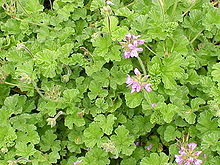
A rose is either a woody perennial flowering plant of the genus Rosa, in the family Rosaceae, or the flower it bears. There are over three hundred species and tens of thousands of cultivars. They form a group of plants that can be erect shrubs, climbing, or trailing, with stems that are often armed with sharp prickles. Their flowers vary in size and shape and are usually large and showy, in colours ranging from white through yellows and reds. Most species are native to Asia, with smaller numbers native to Europe, North America, and northwestern Africa. Species, cultivars and hybrids are all widely grown for their beauty and often are fragrant. Roses have acquired cultural significance in many societies. Rose plants range in size from compact, miniature roses, to climbers that can reach seven meters in height. Different species hybridize easily, and this has been used in the development of the wide range of garden roses.

Geranium is a genus of 422 species of annual, biennial, and perennial plants that are commonly known as geraniums or cranesbills. They are found throughout the temperate regions of the world and the mountains of the tropics, with the greatest diversity in the eastern part of the Mediterranean region.

Pelargonium is a genus of flowering plants that includes about 280 species of perennials, succulents, and shrubs, commonly called geraniums, pelargoniums, or storksbills. Geranium is also the botanical name and common name of a separate genus of related plants, also known as cranesbills. Both genera belong to the family Geraniaceae. Carl Linnaeus originally included all the species in one genus, Geranium, and they were later separated into two genera by Charles Louis L'Héritier de Brutelle in 1789.

Pelargonium radens, the rasp-leaf pelargonium is a species of Pelargonium. It is in the subgenus Pelargonium along with Pelargonium crispum and Pelargonium tomentosum.
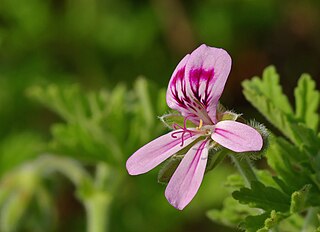
Pelargonium graveolens is a Pelargonium species native to the Cape Provinces and the Northern Provinces of South Africa, Zimbabwe and Mozambique.

Erodium is a genus of flowering plants in the botanical family Geraniaceae. The genus includes about 60 species, native to North Africa, Indomalaya, the Middle East, and Australia. They are perennials, annuals, or subshrubs, with five-petalled flowers in shades of white, pink, and purple, that strongly resemble the better-known Geranium (cranesbill). Cultivated plants are known as filarees or heron's bill in North America, whereas in the British Isles they are usually called storksbills.
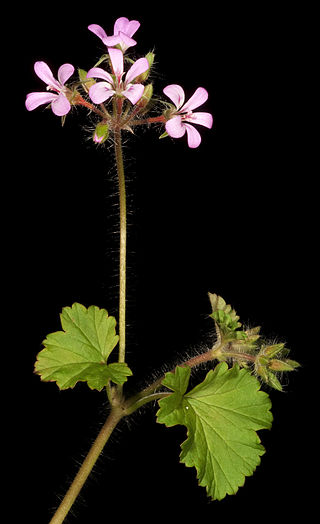
Pelargonium littorale is a species of Pelargonium found within the southwest botanical province of Australia.

Pelargonium peltatum is a scrambling perennial plant with five shallow or deeply lobed, circular- to heart-shaped, somewhat fleshy leaves, sometimes with a differently coloured semicircular band, that has been assigned to the cranesbill family. It carries umbel-like inflorescences with 2–10, white to mauve, bilateral symmetrical flowers, each with a "spur" that is merged with the flower stalk. It is known by several common names including ivy-leaved pelargonium and cascading geranium. It is native to the Cape Provinces of South Africa. In its home range, it flowers year round but most vigorously from August to October.
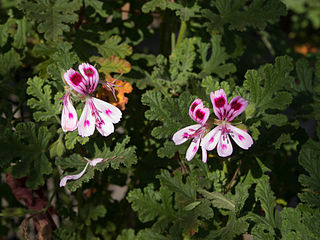
Pelargonium quercifolium is a species of geranium known by the common name oakleaf geranium or oak-geranium. It is native to South Africa, and it is a commonly grown ornamental plant. It is in the subgenus pelargonium along with Pelargonium crispum and Pelargonium tomentosum.
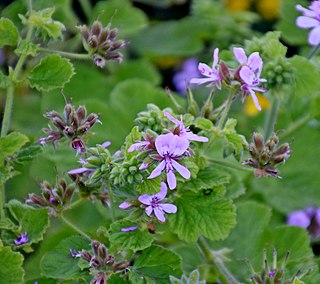
Pelargonium vitifolium is a species of geranium known by the common name grapeleaf geranium. It is a shrub endemic to the Cape Provinces of South Africa. it is a commonly grown ornamental plant. This is a mostly erect, branching shrub approaching one meter in maximum height. The stems are soft and coated in soft hairs when young and become more woody with age. The glandular, stiffly-hairy aromatic leaves are about 6 centimeters long and 8 wide, divided into 5 or 7 toothed, heart-shaped lobes. The inflorescence is a dense umbel of several flowers with five petals each around a centimeter long. The flowers are pink with purplish markings.

Pelargonium × hortorum, commonly called zonal geranium, or garden geranium, is a nothospecies of Pelargonium most commonly used as an ornamental plant. It is a hybrid between Pelargonium zonale and Pelargonium inquinans. They are the group of Pelargonium cultivars, with leaves marked with a brown annular zone and inflorescence in the form of large balls of tight flowers, usually red, pink, or white. These are the most common geraniums of garden centers and florists, sold in pots for windowsills and balconies or planted in flowerbeds.

Pelargonium crispum is a Pelargonium species native to the Western Cape Province, South Africa. It is in the subgenus Pelargonium along with Pelargonium graveolens and Pelargonium capitatum and Pelargonium tomentosum.
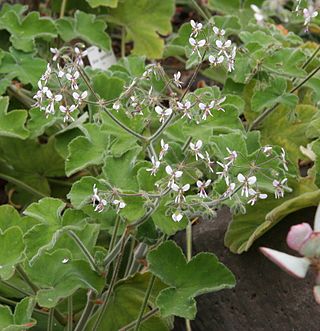
Pelargonium tomentosum, the peppermint-scented geranium, is a pelargonium species native to South Africa. It is in the subgenus Pelargonium along with Pelargonium graveolens, Pelargonium crispum and Pelargonium capitatum.
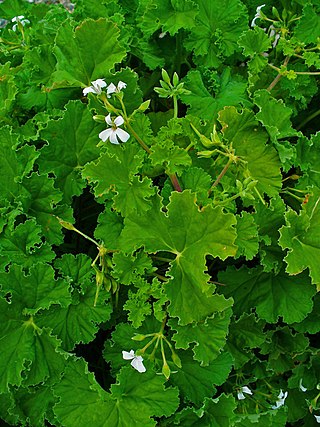
Pelargonium odoratissimum is a pelargonium species native to South Africa. It is also known as the apple geranium or apple pelargonium due to the distinct apple scent. It is in the subgenus Reniforme along with Pelargonium sidoides and Pelargonium exstipulatum.
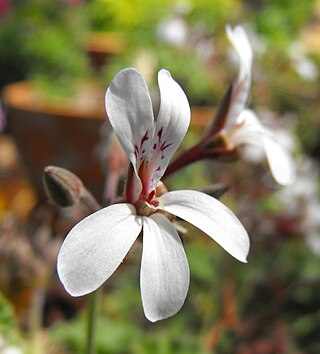
Pelargonium × fragrans is a pelargonium hybrid between Pelargonium odoratissimum and Pelargonium exstipulatum. It is in the subgenus Reniforme along with Pelargonium sidoides and Pelargonium abrotanifolium.

Pelargonium exstipulatum is a pelargonium species native to South Africa. It is in the subgenus Reniforme along with Pelargonium odoratissimum and Pelargonium sidoides.

Pelargonium inquinans, the scarlet geranium, is a species of plant in the genus Pelargonium. It is a shrub endemic to South Africa, ranging from Mpumalanga to KwaZulu-Natal and Eastern Cape provinces. It is one of the ancestors of the hybrid line of horticultural pelargoniums, referred to as the zonal group. They can easily be propagated by seeds and cuttings.
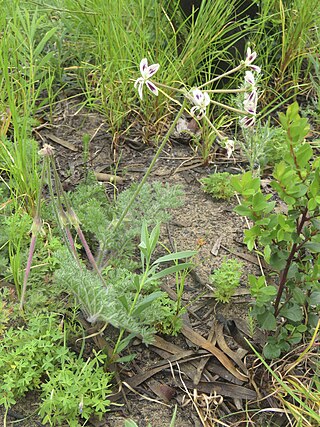
Pelargonium triste, is a geophyte with flowering stems of about 25 cm (9.8 in) high on average, that is assigned to the Stork's bill family. It has hairy, divided and softly feathered leaves that are about twice as long as wide, resemble carrot leaves, and emerge from the tuberous rootstock directly at ground level. The bracts on the flowering stems are usually much smaller than the leaves at ground level. It carries inconspicuous, star-shaped flowers, each with a "spur" that is merged with the flower stalk, with five free green sepals, 5 pale yellow petals, 10 filaments, only 7 of them initially carrying an anther and a style with 5 curved branches. The flowers are crowded in umbels, and mostly there are slight to intense maroon to black markings that may be small or cover the entire petal except for a narrow line along the margins. In the evening, the flowers start to smell like cloves. Flowers may be found practically year round, but most proficiently from September to December. As typical for many species in the Stork's bill family, its fruits resemble the neck, head and bill of a stork. It is known as the night-scented pelargonium in English, kaneeltjie, pypkaneel or rooiwortel in Afrikaans and wit n/eitjie in the Khoi language.
